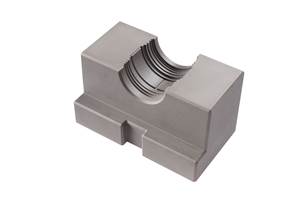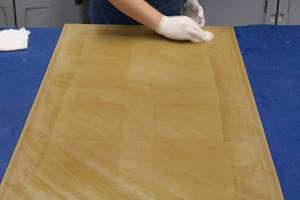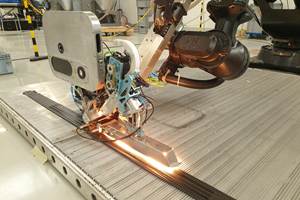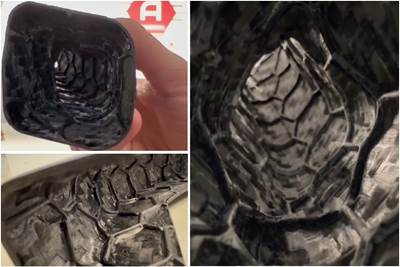Share
Read Next
Addyx (Chieti, Italy) is the developer of the WSM-170 water-soluble expandable mandrel material that enables hollow composite structures. The material is converted into a filament and Addyx uses a standard fused deposition modeling (FDM) printer to fabricate the mandrel, which customers can then use to create hand layup prepreg parts or dry reinforcement preforms to use with resin infusion or resin transfer molding (RTM).
WSM-170 can also be used with Addyx’s patented Carbon Exoskeleton technology, which enables one-shot processing of fiber-reinforced composite ribs on the inside of molded hollow components. “We use a topology optimization program to analyze the composite part,” says Deborah Peca, customer care representative for Addyx. “We identify the areas of most stress and where higher density in ribs is needed, including areas for load transfer. We then complete the engineering of the part with the customer and the final positioning and pattern of the ribs in the 3D printed mandrel.”
During lamination, the ribs are laid first and then layup is completed. The ribs can use towpreg or unidirectional fiber, and Carbon Exoskeleton parts have also been made using filament winding. The completed layup can be cured using an autoclave, oven or heated press, and the mandrel is then dissolved in water with no chemical agents.
“We have also added rotomolding to produce mandrels for series production.”
“Carbon Exoskeleton is used to produce structural parts where the interior surface does not have to be smooth,” Peca notes. “The ribs on the inside of the hollow structure increase stiffness with less weight and cost versus using a sandwich core material or extra reinforcement plies. This approach can be used to upgrade tubular parts such as bicycle frame components, motorsports airfoils and hollow chassis members, as well as car seat structures. The key is that you are improving the stiffness in a very lightweight construction.”
The Carbon Exoskeleton technology enables varying the thickness, width and density of the ribs, says Peca, while topology optimization defines these parameters as well as their arrangement in the structure to ensure maximum strength with minimal material use and weight. Benefits include up to a 30% reduction in layup time and up to 15% less waste.
Notably, the WSM-170 mandrel withstands curing temperatures up to 180°C and becomes an expanding membrane with the application of pressure during curing. “This eliminates the need for an internal vacuum bag,” says Peca, “and enables excellent compaction as well as the ability to integrate not only ribs, but also fastening points, including metal fasteners.”
“We have also added rotomolding to produce mandrels for series production,” she continues. “The 3D printing method is more for prototypes and small series. Rotomolding offers larger volume production for applications in aerospace, for example. We are launching this new production process for mandrels and have started the first projects.”
The rotomolding process uses a machined aluminum mold from a supplier. “We put the WSM-170 polymer inside the mold, but in a powder form, which is also cheaper than converting it into a 3D printing filament,” says Peca. “We then heat and rotate the mold in the machine to create the mandrel, which is completed in 20-30 minutes. We can produce a large quantity of mandrels per day at an affordable cost.”
Related Content
Metal AM advances in composite tooling, Part 2
Toolmakers and molders continue to realize the benefits of additive versus conventional/subtractive manufacturing of molds and mold components.
Read MoreNorco GFRP molds meet high-quality cast concrete beam production needs
A project with P&M successfully achieved manufacture of six 20-meter-long architectural beams for an R&D facility with near-seamless surfaces and on a tight production schedule.
Read MoreProper application of semi-permanent mold release systems
Performing regular maintenance of the layup tool for successful sealing and release is required to reduce the risk of part adherence.
Read MoreATLAM combines composite tape laying, large-scale thermoplastic 3D printing in one printhead
CEAD, GKN Aerospace Deutschland and TU Munich enable additive manufacturing of large composite tools and parts with low CTE and high mechanical properties.
Read MoreRead Next
Addyx carbon exoskeleton technology enables molded ribs inside hollow composite structures
Using a water-soluble mandrel, carbon exoskeleton opens paradigm for topology-optimized composites, cutting weight, manufacturing time and scrap rate.
Read MorePlant tour: Daher Shap’in TechCenter and composites production plant, Saint-Aignan-de-Grandlieu, France
Co-located R&D and production advance OOA thermosets, thermoplastics, welding, recycling and digital technologies for faster processing and certification of lighter, more sustainable composites.
Read MoreDeveloping bonded composite repair for ships, offshore units
Bureau Veritas and industry partners issue guidelines and pave the way for certification via StrengthBond Offshore project.
Read More
























